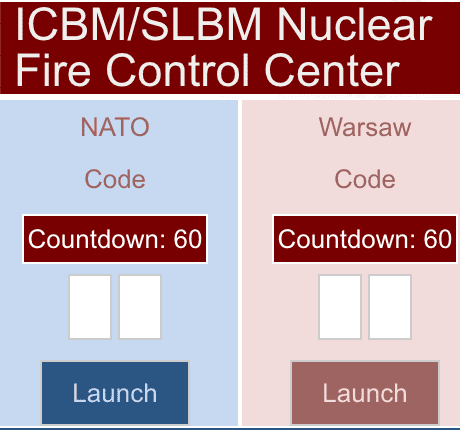Interactive Cold War Map Activity
CREATE AN INTERACTIVE CLASSROOM WITH OUR ENGAGING, HANDS-ON COLD WAR SIMULATION
Help your students understand what it felt like to live as a leader during the Cold War Era. The Cold War is one of those topics/eras that may seem boring to kids on the surface- compared to the Second World War, but really, the stakes were even higher!
The Cold War Simulation allows students to feel the concepts of Escalation, Mutually Assured Destruction and especially fear, through the pathway of a simulated Nuclear War.
Students will be placed into scenarios similar to that of Harry Truman and Joseph Stalin in the Berlin Crisis and John F. Kennedy and Nikita Khrushchev In the Cuban Missile Crisis.
Students will take the roles of the leaders of NATO and Warsaw Pact countries during the Cold War. Each Alliance has a decision making process similar to that during the Cold War. Each country has Armored Divisions, Some also have Tactical Nuclear Weapons and ICBM's/SLBM's.
Help your students feel what the Cold War was like during this era. Give your students an experience they will still be talking about at their ten year high school graduation reunion!
Try our online demo
Cold War Games Online Demo
Email Login: demo@historysimulation.com (Not an email)
Password: demo123
Students Feel the Intensity, As Thousands of Tanks Converge On the Plains of Europe In a Conventional War!
As The Defense Condition Rises, So Does The Intensity In The Classroom!
DEFCON 5 is the normal state of readiness for both Alliances. Throughout the Cold War this was the normal state of alert.
Both NATO and Warsaw Pact Forces had Armored Divisions poised on opposite sides of the border. Normal Readiness meant that each side was ready to go to war at any moment.
DEFCON 4 is when all forces are put on high alert. Students will change their alert status to show the increased tension and their readiness to make war. Neither side wants to show fear or to make the other side think they don't have the guts to go all the way.
DEFCON 3 The intensity increases as Nuclear Submarines take up firing positions with their Sea Launched Ballistic Missiles ready to launch!
DEFCON 2 The situation is now reaching crisis level, as both sides have ordered their bombers to their failsafe positions ready to launch a nuclear attack!
DEFCON 1 Once we reach Defcon 1, one side or both is preparing to enter the launch codes for an all out nuclear strike! ICBM's turn red as all missiles are hot and ready for launch!
All Out Nuclear Strike
At this point in the game, the launch codes have been entered and the 60 second countdown has begun. The tension in the room is high and even though they know this is just a game, you can see the fear building as the clock counts down.
As the nuclear detonations appear on the map, there is no question that the students realize that nobody can win a nuclear war. Students are now much more interested in learning about the Cold War as they know what the stakes were.
National Social Studies Standards of the United States Era 9- The 20th Century Since 1945: Promises and Paradoxes
Standard 1: How Post World War II reconstruction occurred, new international power relations took shape, and colonial empires broke up.
Standard 1B: The student understands why global power shifts took place and the Cold War broke out in the aftermath of World War II.
Therefore, the student is able to:
Explain how political, economic and military conditions prevailing in the mid 1940's led to the Cold War. (Analyze Cause and Effect Relationships)
Analyze major differences in the political ideologies and values of the Western democracies and the Soviet Bloc. (Compare and contrast different ideas, values and institutions.
Compare the impact of Soviet domination on Eastern Europe with changes that occurred in Japanese and German Society under allied occupation. (Compare and contrast differing values behaviors and institutions)(Not all standards covered in this lesson plan)
Interactive Cold War Lesson Activity
Give your students opportunities to engage with their learning and have fun with our interactive Cold War lesson activity. Our goal is to provide you with the tools to help students understand and confront the complex situations that led to the Cold War so that they can compare the different ideologies.
Benefits of an Interactive Lesson
The interactive Cold War activity allows students to make difficult decisions, which means they can better comprehend the concepts and improve their decision-making skills at the same time. Try our online demo to experience it for yourself.
Interactive activities are a great way to encourage students to engage with the lesson. We believe that combining education and fun can stimulate learning and productive conversations. Our hands-on simulation is easy to use and will create an unforgettable classroom experience.
If you are ready to try the interactive Cold War activity or have questions, feel free to e-mail us today.
Cold War Game Tutorials
Cold War Simulation Preview
Online Map Preview
Student Tutorial
Additional Information
You can contact us at
(515) 689-3960
or write to us at
historysimulation.com@gmail.com.







